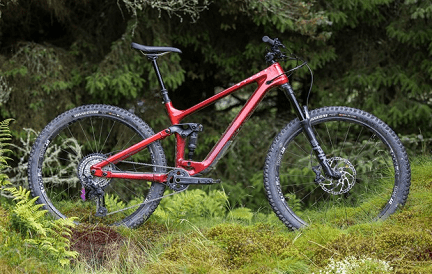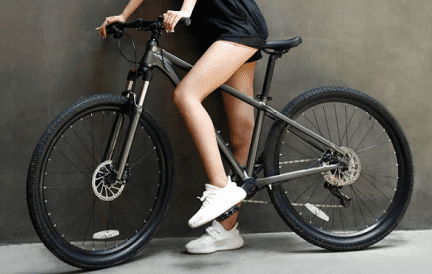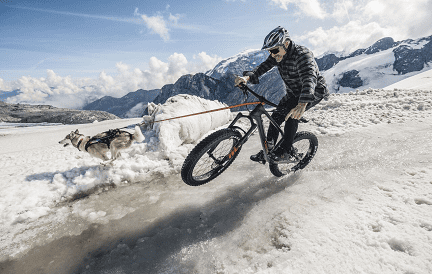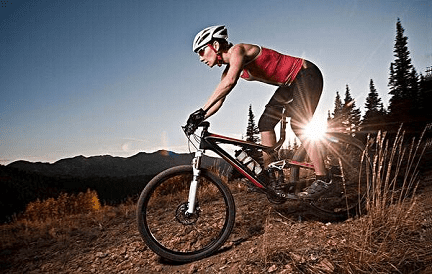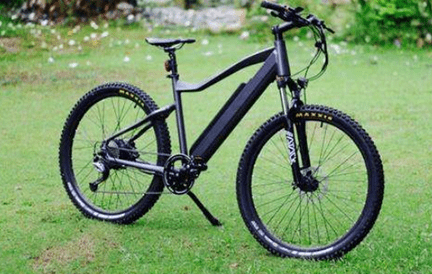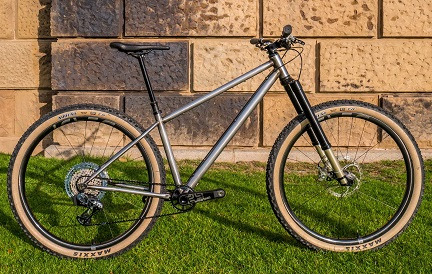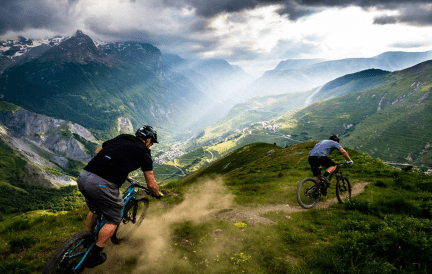Mtb hardtail bikes are bikes without rear shocks. It is good for various terrains. Choosing a hardtail mountain bike might be a little intimidating. Luckily in this article, we will cover choosing a hardtail mountain bike.
- Part 1: What is a Mountain Bike
- Part 2: What is a Hardtail Mountain Bike
- Part 3: What is a Full-suspension Mountain Bike
- Part 4: Styles of a Mountain Bike
- Part 5: Selecting a Hardtail Mountain Bike
- Part 6: Summary
Part 1: What is a Mountain Bike
Mountain bikes, known as mtb, are a type of bike specifically intended for off-road cycling. Mountain bike’s features are designed to improve durability and performance on tough terrain. Because of their features, they are heavier than normal bikes, and it is less efficient on flat terrain. They often contain a suspension fork, huge knobby tires, stronger wheels, stronger brakes, and straight, extremely wide handlebars. These components help the rider improve their balance over rough terrain.

Mountain bikes are primarily designed for usage on rough surfaces such as mountain trails, single track, fire roads, etc. The mountain riding terrain usually contains rocks, roots, loose dirt and steep climbs.
Mountain bikes differ into two categories which are hardtail and full suspension. Meanwhile, they are a few styles of mountain bikes, such as cross-country (XC), trail, enduro(all-mountain), downhill and fat bikes. They differ in their usage on certain terrain; for example, cross-country is not optimal on steep terrain. The trail style is lighter and can handle rough terrain. Meanwhile, the enduro and downhill bikes are good for steep terrain. Lastly, the fat bike, which has wide tires, can handle soft, unstable terrain such as snow and sand.
Mountain biking is a high-intensity activity that provides an intense workout for your body in comparison to traditional biking. When you ride, you are not only working out your legs and improving your heart and lungs but also your upper body. Cycling also helps riders improve their coordination, balance, and stability. It’s also a calming and stress-relieving exercise since we’re exploring the outdoors and passing through changing landscapes. The trails vary from leisurely rides along broad, flowing logging roads to high-adrenaline singletrack. Although the bike’s name is a mountain bike, this does not imply that you must ride it on a mountain.
Part 2: What is a Hardtail Mountain Bike
A hardtail mountain bike, often known as a hardtail bike or hardtail mtb, is a type of bicycle for riding on a range of off-road terrains. A hardtail mountain bike, as the name implies, lacks rear shocks but does have a front suspension fork. A hardtail bike’s front suspension aids riders in handling challenging off-road terrain. When riding over lumps, bumps, and jumps, the front suspension absorbs some of the shocks, relieving the rider of strain. Hardtails are recognized and well-known for their versatility. Additionally, they are a more cheap, sturdy, and adaptable alternative for riders interested in venturing off the road or mountain riding.
A hardtail mountain mtb is versatile in a variety of terrains and conditions. Their adaptability and resilience ensure that they will perform effectively in most riding environments. Mountain trails, fire roads, and pump tracks are suitable for hardtail mountain riding. Hardtail mtb is also excellent for less experienced riders. Besides that, it can also excel on the less intensive routes, such as gravel and stone trails, woods pathways and even city streets. Due to their lightweight, hardtails are ideal for ascending steep hills.
Part 3: What is a Full-suspension Mountain Bike
As you may expect, a full-suspension bike will have front and rear suspension, allowing for effortless maneuvering over more tough terrain. Full-suspension bikes are designed to handle tough terrain. This implies they are less effective on flat surfaces. Because of their front and rear suspension, riders may feel more comfortable when the bike gets an impact.
The full-suspension bikes are designed for riding along steep paths. While a hardtail might help with the uphill, the descent can be a real pain. With a full-suspension bike, you can sit back and relax more since your descent will be more balanced and controlled. The downsides of the full-suspension bikes are that their price is higher than hardtail bikes. They are also heavier, making them not ideal for climbing hills.
Part 4: Styles of a Mountain Bike
As we mentioned earlier, mountain bikes have differences in some styles, such as cross-country, trail, enduro, downhill and fat bikes. In this part, we will explain their characteristics and functions.
Part 4.1: Cross-country
Cross-country mountain bikes are a bike that is intended to traverse a range of off-road terrain quickly. They are designed to be equally adept at climbing as well as descending while also being efficient on flatter terrain. Cross-country bikes are often the lightest style of mountain bikes. They are often made of carbon fiber, while more budget aluminum models are also available. Cross-country bikes are primarily designed for racing, but they can also be used on mellower trails because of their versatility.
Cross country mountain bikes are ideal for riders who want to cycle for extended periods of time and who prioritize ascending over descending. They can ascend well because of their lightweight body. Their wheels are also durable, efficient and faster at rolling. The majority of cross-country mountain bikes include front suspension. However, shock travel is often regulated to maximize pedaling efficiency and speed. Their geometry is good for climbing hills and navigating a racing course rapidly.
Part 4.2: Trail
The most popular type of mountain bike is the trail bike, which is excellent for daily usage.
You might call it an all-around bike because of its flexible design. They are great at enduring challenging terrain while giving sufficient speed. Besides that, they are also lightweight and offer great comfort. As a result, it is sometimes referred to as the mountain bike with the most versatility.
These bikes are available with front or full suspension and have a price range ranging from extremely low to extremely expensive. They are capable of descent but are more suited to rising and flat terrain.
Part 4.3: All-Mountain (Enduro)
As the name implies, the All-Mountain or Enduro is the bike for mountainous or hilly terrain, also for long travel rides. In general, they are a cross between trail and downhill bikes. The bike’s frame is virtually identical to that of a trail bike. The most notable distinctions are in the suspension, stem, and handlebars. Their suspension travel is greater than that of a trail bike, and they almost always include full suspension.
The Enduro bike is very suitable for a rider that likes to descent. Their geometry is ideal for descending but also for pedaling back uphill to begin the next stage of the race.
Part 4.4: Downhill
Downhill bikes are bikes designed especially for downhill. They have a slack frame design that keeps the rider in a more comfortable and controlled position, allowing for smoother handling at high speed. They can safely and quickly transport you down a mountain due mainly to their lengthy travel, aggressive geometry, and ultra-durable components.
As a result, riders attempting to use it on terrain other than downhill will find it exceedingly difficult and inefficient to use. Rather than riding a route or trail to the peak, the majority of downhill bikers will walk or carry their bikes.
Part 4.5: Fat Bike
A fat bike (alternatively spelled fatbike, fat tire, fat-tire bike, or snow bike) is an off-road bike with bigger tires. Their common wheel size is 3.8 in (97 mm) or larger and rims 2.16 in (55 mm) or wider. The wide tires enhance grip and traction allowing the rider to pedal over terrain that would sink standard tires. The tires could reduce ground pressure, allowing riders to ride over soft, unstable terrain like snow, sand, bogs, and mud.
As the name implies, the weight of a fat bike is heavier than common a mountain bike. Despite the additional weight, they’re fairly simple to ride uphill as well. It may not be the fastest climber, but with enough traction, It can maintain a steady pace.
Part 5: Selecting a Hardtail Mountain Bike
Off-road riding demands components that are tough enough to survive the challenges of mountain biking. When choosing a hardtail mountain bike, consider the following components.
Part 5.1: Frame Material
Aluminum and carbon fiber are the two main materials in bike manufacture. Aluminum is more affordable, lighter, and more durable than carbon fiber. You can afford a few bumps and collisions without affecting the structural integrity of the frame. Aluminum’s resistance to severe surroundings gives it a considerable advantage in damping vibrations and absorbing impact.
Carbon fiber, on the other hand, is more costly and lighter. Although carbon is a solid material, it is fragile and hence cannot deliver the precise tolerances offered by aluminum. As a result, collisions and rock hits are more likely to shatter the frame than to harm it. On the other hand, the strength of carbon fiber compensates for its brittleness.
Part 5.2 Front Suspension
Hardtail mountain bike only offers front suspension, which is accomplished by using a fork component. The front suspension has a hydraulic mechanism that enables the front tire to rise and fall in response to unstable terrain. The fork legs, sometimes called stanchions, vary in length. They are referred to as travel and are often expressed in millimeters. You should aim for a distance between 100mm and 120mm for cross-country trails. You may want to look for travel between 130mm and 150mm for all-mountain trail riding.
Part 5.3 Brakes
When it comes to selecting a hardtail mountain bike, the brakes are one of the most crucial components. They not only bring you to a complete stop but also assist with trail speed control. Typically, a hardtail mountain bike has two types of brakes. The first is the disc brake, which is the favorite option of stopping for mountain bikers due to its rapid response time and robust braking system. Certain disc brakes use hydraulic systems that come in various layouts and price ranges. They are relatively simple to maintain and upgrade if you need extra braking power.
The second type of brake is the rim brake; these are less costly and require less maintenance. On the other hand, Rim brakes are not good for fast trail riding. The reason for that is that their effectiveness is down when wet.
Part 5.4 Wheels
27.5″ and 29″ are the most common wheel sizes. Historically, cross-country riding required larger 29-inch wheels. While the 27.5″ wheel is lighter, it allows for better maneuverability when riding in narrow areas. Choosing a wheel is often a matter of personal choice; thus, we advise you to test it before purchasing.
Part 5.5 Buying the Bike
The first step is to establish a personal budget. Bikes may quickly become expensive, so having a spending limit is a smart idea. You can purchase an mtb hardtail in person at a bike shop, online, or via second-hand merchants and individuals. Never underestimate the second-hand market since you may come upon an incredible bargain.
The next step is to test the bike; this might offer insight into what type of bike is best for you. Certain companies provide demo days in bike parks and trail centers, during which you may receive trail guidance and test rides. Bike stores are another wonderful option for physically inspecting and feeling the bike. Depending on the stores, you may even ride the bike around the parking lot.
Part 6: Summary
Mountain bikes are bikes that can handle various terrain. They differ into two types which are hardtail and full-suspension. A hardtail is a mountain bike without front suspension. On the other hand, the full-suspension offers rear and front suspension. Before buying a hardtail mountain bike, it is better to consider a few components such as the frame, front suspension, wheels and brakes. After analyzing the components, don’t forget to test out the bike to find out if the bike is the right one for you.

